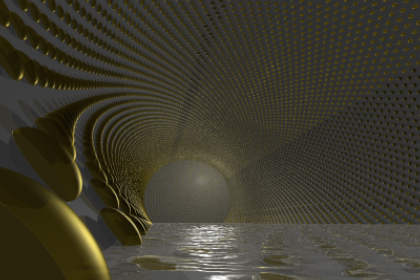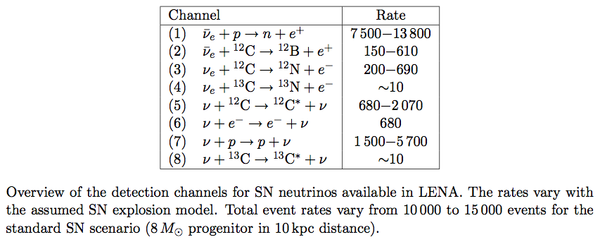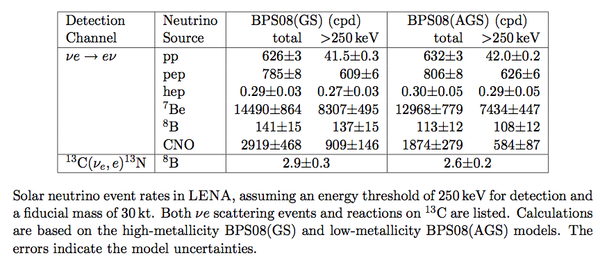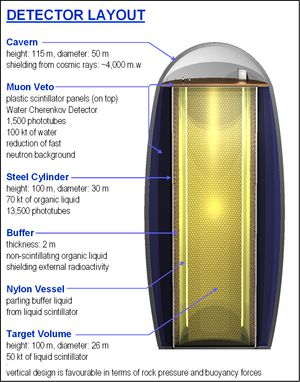Low Energy Neutrino Astronomy
Introduction
In the last few years, important discoveries have been made in the field of low energy neutrino physics. Flavour transitions of solar electron to muon and tau neutrinos have been clearly shown in the SNO experiment. Further evidence for neutrino oscillations has been found in the KamLAND experiment by a disappearence measurement of electron antineutrinos emitted by nuclear reactors. In 2007, the Borexino experiment started to take data, demonstrating the great potential of the liquid-scintillator technique for the detection of solar and geoneutrinos. Based on this experience, LENA has been proposed as a next-generation neutrino detector: Based on a 50 kiloton target of liquid scintillator, LENA will use low-energy neutrinos as probes for studying astrophysical objects like the Sun, core-collapse Supernovae and the Earth itself. The scientific program will also cover elementary particle and neutrino physics as well as the search for nucleon decay.
The Detector
- The present design of LENA foresees a cylindrical detector of about 100 m length and 30 m diameter. An inside part of 13 m radius containing 50 kilotons of liquid scintillator is separated from a non-scintillating buffer region by a nylon barrier. A steel or concrete tank separates this inner detector from an outer water tank that is used both for shielding and as an active muon veto.
- About 45,000 photomultipliers of 20 cm diameter each will be mounted to the internal walls of the detector to collect the scintillation light. The optically active area will be enhanced by conic mirrors mounted to the individual PMTs, corresponding to a surface coverage of about 30%.
- LAB (linear alkylbenzene) is currently the favored solvent for the liquid scintillator in LENA. Besides its high light yield and large attenuation length it has the advantage of being a non-hazardous liquid (HMIS ratings <1). Laboratory experiments have shown that attenuation lengths of 10 to 20 m (@ 430 nm) and a photoelectron yield of >200 pe/MeV can be achieved for a scintillator mixture containing 2g/l PPO and 20 mg/l bisMSB as wavelength shifters. Optical tests concerning the large-scale light transport and the differences in scintillator response for alpha-, beta- and gamma-particles as well as protons are on-going. Purified PXE or a mixture of PXE and dodecane are alternative solvent options.
 |
Detector Sites
Possible locations for LENA are currently evaluated in the frame of the LAGUNA site study. Important aspects for the site selection is the maximum detector cavity depth that provides shielding from cosmic rays, the distance to the next nuclear power plants, the distance to CERN regarding a possible long-baseline neutrino beam experiment, and the amount of already available infrastructure. In this respect, two of the seven sites discussed in LAGUNA excel:
- Center for Underground Physics in Pyhäsalmi (CUPP, Finland)
currently the preferred location
Shielding: 1450 m of rock (4060 m.w.e.)
Muon Flux: 10-4 m-2s-1
Reactor anti-ve Flux: 1.9 x 105 cm-2s-1
Radioactivity: Rn < 70 Bq/m3
Accessibility: truck road - Laboratoire Souterrain de Modane (LSM, Frejus, France)
Shielding: 1700 m of rock (4800 m.w.e.)
Muon Flux: 0.5x10-4 m-2s-1
Reactor anti-ve Flux: 1.6 x 106 cm-2s-1
Accessibility: highway tunnel
Physics
- Supernova Neutrinos
A 8 solar masses supernova exploding in the centre of the milky way (10 kpc distance) typically will induce a signal rate of ~15000 events in LENA. The rates of the different reactions channels are listed in the table below. The golden channel is the inverse beta decay that provides a high-statistic signal of electron antineutrinos. A discrimination between electron neutrinos and electron antineutrinos is possible by charged current reactions on Carbon: both electron neutrinos and antineutrinos interact on Carbon-12, providing a coincidence by the re-decay of the produced Nitrogen or Boron nucleus. In this way, LENA can provide information on ve and anti-ve fluxes and spectra.
The neutral current reactions will be sensitive to all neutrino flavours and thus determine the total flux.
Due to the high statistics of the neutrino detection a time-resolved neutrino-flux rate for different neutrino interactions could be measured which would give new results on the dynamics of supernova explosions and would be complementary to the information accessible in large water-Cherenkov detectors or in a large liquid-Argon detector. Deformations in both the v and anti-v spectra could be caused by matter effects in the supernova as well as the Earth. Their detection would constrain the third mixing angle theta13 and give evidence for an inverted neutrino mass hierarchy.

- Diffuse Supernova Neutrino Background (DSNB)
The faint flux of neutrinos produced by Supernova (SN) explosions on cosmic distances potentially provides valuable information on both the average supernova neutrino spectrum and the red-shift dependent Supernova rate. The current best upper limit on the DSNB-flux is held by the SuperKamiokande experiment: The electron antineutrino flux is smaller than 1.2 /cm**2s above an energy threshold of 19.3 MeV.
Like Water Cherenkov detetcors, LENA will rely on the inverse beta decay reaction for the detection of the electron antineutrino component of the DSNB. As both positron and neutron of the final state can be detected, LENA is able to discriminate most of the background events present in Water Cherenkov detectors: solar neutrinos, invisible muons from atmospheric neutrinos, and cosmogenic spallation products.
LENA's observational window for the DSNB reaches from about 10 to 25 MeV, limited by the irreducible backgrounds of reactor antineutrinos at low energies and atmospheric electron antineutrinos at high energies. There are other sources of background that are induced by cosmic muons: Cosmogenic beta-n-emitters are produced by muons crossing the scintillation target but easily vetoed using the coincidence with the muons. Fast neutrons created by muons passing the detector in the rock may propagte into the target volume and produce coincidence-like signals but can be reduced by a sufficiently large outer water buffer. Studies whether NC-reactions of atmoshperic neutrinos on carbon might pose a severe background are currently on-going.
According to models that calculate the expected DSNB flux by using SN neutrino input spectra and the optically measured star formation and SN rate as an input, about 2-20 events per year are expected inside the observation window in LENA. Cuts from pulse shape analysis used for background discrimination might reduce this number, but a positive identification of the signal seems assured.
There is also the opportunity to use the astronomical data on the SN rate up to redshifts of 2 to deconvolute the average SN neutrino spectrum and to determine the mean neutrino energy. The precision of this measurement depends on the actual statistics determined by the observed flux, detection efficiency and exposure. Here, a low reactor background and therefore low energy threshold will be very valuable, as recent SN models point towards comparatively low mean spectral energies which shift a large fraction of the DSNB signal to energies below 10 MeV. - Solar Neutrinos
Liquid-scintillator detectors offer the opportunity for a spectrally resolved measurement of the solar neutrino spectrum, even at sub-MeV energies. In the last years, Borexino has splendidly demonstrated the potential of this detection technique. It seems well feasible to reach the excellent background conditions of Borexino in LENA, as the smaller ratio of surface to volume decreases the chance that the scintillator is contaminated with radioimpurities.
Based on Monte Carlo simulations of the gamma background rates to be expected from the uranium, thorium and potassium of the PMT glass, a fiducial volume of the order of 30 ktons is achievable for solar neutrino detection. Based on the unprecedented statistics, LENA will be able to address topics both in neutrino oscillations and in solar physics:
The MSW-LMA solution for solar neutrino oscillations predicts a drop in electron neutrino survival probability in the region from 1-5 MeV that has been confirmed by observation. However, the shape of the transition curve could give an indication for new oscillations physics and has up to now not been determined. A high-statistics measurement of the B-8 neutrino survival probability in the energy range below 5 MeV will allow to investigate the upper part of the transition region, while a measurement of the pep neutrino line at 1.44 MeV will probe the lower part. In addition, charged current reactions on carbon-13 provide meaningful rates in LENA. The coincidence event signature allows to investigate the survival probability to even lower energies.
B-8 neutrinos offer also the chance to look for the non-standard conversion of neutrinos in antineutrinos induced by the solar magnetic field. It should be noted that the DSNB is a background to this search and vice versa.
Quite recently, a new analysis of the solar metal contents by study of the Fraunhofer lines in the solar spectrum have returned low values for solar metallicity, in severe conflict with the data obtained by helioseismology. A accurate measurement of Be-7, B-8 and especially CNO neutrino flux can be used to determine the metallicity in the solar center and potentially solve this question. LENA is here in a favorable position, as meaningful statistics can be obtained in short times and in both Pyhäsalmi and Frejus, the cosmogenic background of carbon-11 will be substantially lower than in Borexino.
About 15,000 electron-scattering events per day are expected from the monoenergetic Be-7 neutrino line. This provides the possibility to search for periodic modulations in the neutrino flux at per mill amplitudes and for short time scales. Such fluctuations have been proposed as a consequence of helioseismic g-waves present at the solar center that are otherwise unobservable.

- Geoneutrinos
Unique information on the interior of the Earth can be obtained by the detection of electron antineutrinos from the Earth. Present technology permits drilling of holes down to a depth of approximately 10 km, compared to the Earth radius of ~6300 km. It is known that the emitted heat from the Earth exceeds the energy flow from the Sun by around ~40 TW. This excess is generally attributed to heat emitted by natural radioactivity of material inside the Earth. However, estimations of the Earth's interior composition account only for half of the radioactivity required. Part of the missing energy may be covered by latent heat emitted in geochemical processes. A precise measurement of the antineutrino flux emitted by the elements of uranium and thorium decay chains embedded in the terrestrial matter will provide valuable information to solve this question.
These so-called geoneutrinos have been measured in 2005 for the first time by the liquid-scintillator detector KamLAND, and quite recently by Borexino, providing clear evidence of the signal. Up to now, statistics are not sufficient to rule out geochemical models or to determine the ratio of uranium and thorium in the Earth's crust and mantle. However, a detector of the size of LENA will provide sufficient statistics (about 1,000 events per year) for a precise flux measurement and a spectral separation of U/Th. In combination with the measurements of other detectors, even crust and mantle contributions to the overall flux could be separated.
The best upper limit for the power of a natural georeactor at the Earth's center is currently at 3 TW, relying on the non-appearance of a corresponding reactor neutrino flux in Borexino. Provided that LENA is built at a site far from nuclear power reactors, this limit could be further reduced. - Proton Decay
A large scintillation detector provides unique sensitivity to the proton decay into charged kaon and antineutrino. This is due to the clear double-peak structure which arises from the energy deposited by the kaon and by its decay products. This signature allows for the discrimination of background due to atmospheric neutrino reactions in the detector, resulting in a detection efficiency of about 65%. The decay mode into kaon/antineutrino is favoured in many supersymmetric theories: Typical predictions for the life time are not larger than t=10^35 years. The best experimental limit on this decay mode is provided by the Super-Kamiokande experiment with t>2.3 x 10^33 years. Monte Carlo simulations indicate that LENA will be able to substantially increase the life time limit for this decay mode. Provided an exposure of 0.5 Mton years (10 years of measurement), a life time lower than 4 x 10^34 years can be excluded at 90% C.L.. - Atmospheric neutrinos/Long-baseline neutrino beams
A meaningful analysis of neutrino events at GeV energies, as they can be expected from atmospheric neutrinos and long-baseline experiments, depends on the possibility of particle tracking in the detector. While demonstrated for water Cherenkov and liquid-argon detectors, the possibility to use an unsegmented LSD has been neglected for a long time. However, basic features of track reconstruction are used even today for cosmic muons in the Borexino and KamLAND experiments.
Recent studies indicate that a large-volume detector like LENA is able to resolve both momentum and energy of GeV particles on a level of a few percent. Moreover, Monte Carlo simulations studying the reconstruction capability of a liquid-scintillator detector for the complex event topologies of charged-current neutrino interactions show promising results. These techniques offer the opportunity to complement the rich low-energy physics program of LENA by long-baseline neutrino oscillation experiments, either from atmospheric neutrinos or an accelerator-produced neutrino beam. Detailed studies on the discrimination of neutral current backgrounds and resolution of complex event topologies are on-going.
LAGUNA meetings
LAGUNA - Large Apparatus for Grand Unification and Neutrino Astrophysics
LENA meets KM3NeT
Photo sensor R&D meeting (Garching, 4th of February 2011)
HanoHano meets LENA
Meeting (Munich, 20th/21st of July 2009)
Publications
- M. Wurm et al., The next-generation liquid-scintillator neutrino observatory LENA, Astropart. Phys. 35 (2011) 685-732, arxiv:1104.5620
- M. Wurm et al., The physics potential of the LENA detector, Acta Phys. Pol. B 41 (2010) 1749, arxiv:1004.3474
- M. Wurm et al., Optical scattering lengths in large liquid-scintillator neutrino detectors, Rev. Sci. Instrum. 81 (2010) 053301, arXiv:1004.0811
- T. Marrodan Undagoitia et al., Spectroscopy of electron-induced fluorescence in organic liquid scintillators, Eur. Phys. J. D 57, 105 (2010), arXiv:1001.3946
- T. Marrodan Undagoitia et al., Fluorescence decay-time constants in organic liquid scintillators, Rev. Sci. Instrum. 80 (2009) 043301, arXiv:0908.0616
- J. Peltoniemi, Simulations of neutrino oscillations for a wide band beam from CERN to LENA, (2009), arXiv:0911.4876
- J. Peltoniemi, Liquid scintillator as tracking detector for high-energy events, (2009) arXiv:0909.4974
- D. Autiero et al., Large underground, liquid based detectors for astro-particle physics in Europe: scienti c case and prospects, J. Cosm. Astrop. Phys. 0711 (2007) 011, arXiv:0705.0116
- M. Wurm et al., Detection potential for the diffuse supernova neutrino background in the large liquid-scintillator detector LENA, Phys. Rev. D 75, 023007 (2007), astro-ph/0701305
- T. Marrodan Undagoitia et al., Low energy neutrino astronomy with the large liquid scintillation detector LENA, Prog. Part. Nucl. Phys. 57 (2006) 283, hep-ph/0605229
- K. A. Hochmuth et al., Probing the Earth's interior with a large-volume liquid scintillator detector, hep-ph/0509136
- T. Marrodan Undagoitia et al., Search for the proton decay p->K+antineutrino in the large liquid scintillator low energy neutrino astronomy detector LENA, Phys. Rev. D 72 (2005) 075014, hep-ph/0511230
- L. Oberauer, F. von Feilitzsch, W. Potzel, A large liquid scintillator detector for low-energy neutrino astronomy, Nucl. Phys. B (Proc. Suppl.) 138 (2005) 108
Contributions to Conferences
- M. Tippmann, Development of an Optical Module for LENA, DPG Frühjahrstagung 2012, Göttingen, Germany (February 2012)
- M. Tippmann, Design and FEA simulations of pressure withstanding PMT encapsulations for LENA and Algorithms to identify fast afterpulses on a previous pulse, Light2011, Ringberg, Germany (October 2011)
- M. Tippmann, LENA Photosensor R&D, DPG Frühjahrstagung, Karlsruhe, Germany (March 2011)
- M. Tippmann, Low Energy Neutrino Astronomy, ASPERA Technology Forum, Munich, Germany (October 2010)
- M. Tippmann, LENA Detector development, ANT 2010, Santa Fe, USA (September 2010)
- J. Peltoniemi, LENA: A tracking detector?, LAGUNA general meeting, Canfranc (2010)
- T. Marrodan Undagoitia, Neutrino astrophysics and particle physics in LAGUNA, Seminars on Astroparticle Physics, DESY Hamburg (2010)
- M. Wurm, Low Energy Neutrino Astronomy, PICS kick-off meeting, APC Paris (2010)
- M. Wurm, The Physics Potential of the LENA Detector, Epiphany Conference, Cracow (2010)
- T. Marrodan Undagoitia et al., Projects for low energy neutrino: LAGUNA, LENA and Hano-Hano, Neutrino Champagne, Reims, France (2009)
- T. Lachenmaier, LENA - Scintillator R&D, NNN09, Estes Park CO, USA (2009)
- M. Wurm, Large Volume Liquid-Scintillator Detectors, Advances in Neutrino Technology, Honolulu HI, USA (2009)
- M. Wurm, LENA Scintillator Development, Advances in Neutrino Technology, Honolulu HI, USA (2009)
- L. Oberauer, Prospects of LENA, Workshop Towards Neutrino Technology, Trieste, Italy (2009)
- T. Marrodan Undagoitia, Proton decay and neutrino astrophysics with the future LENA detector, NNN08, Paris, September 2008
- M. Wurm, Low Energy Neutrino Astronomy in the future large-volume Liquid-Scintillator Detector LENA, Poster @ Neutrino 08 in Christchurch, New Zealand, May 2008
- T. Marrodan Undagoitia, LENA: A multipurpose detector for low energy neutrino astronomy and proton decay, TAUP 07, September 2007
- M. Wurm, Nucleon Decay Search in LENA, DOANOW 07 Honolulu, Hawaii, March 2007
- T. Marrodan Undagoitia, A multipurpose detector for low energy physics LENA, DPG Meeting in Heidelberg, March 2007
- J. Winter, Looking into the centre of a supernova with LENA, DPG Meeting in Heidelberg, March 2007
- M. Wurm, Search for the Diffuse Supernova Neutrino Background in LENA, DPG Meeting in Heidelberg, March 2007
- M. Wurm, Analysis of the Optical Properties of Organic Liquid Scintillator in LENA, DPG Meeting in Heidelberg, March 2007
- T. Marrodan Undagoitia, Potential of the large liquid-scintillator detector LENA in particle and astrophysics, DPG Meeting in Dortmund, April 2006
- M. Wurm, Detection of the Diffuse Supernova Neutrino Background in LENA & Study of Scintillator Properties, DPG Meeting in Dortmund, April 2006
- L. Oberauer, LENA, 3rd International Workshop on NO-VE "Neutrino Oscillations in Venice", Italy, February 2006
- M. Wurm, Investigation of Optical Scintillation Properties and the Detection of Supernovae Relic Neutrinos in LENA, E15 Seminar, TU Muenchen, Germany, January 2006
- T. Marrodan Undagoitia, Search for the Proton Decay in the large liquid Scintillation Detector LENA, TAUP05 Zaragoza, Spain, September 2005
- L. Oberauer, LENA - Low Energy Neutrino Astrophysics, TAUP03 Seattle, US, September 2003
Bachelor, Diploma and PhD Theses
- M. Nöbauer, Entwicklung eines Testaufbaus für Photomultiplier im Rahmen des LENA-Projekts, Diploma thesis, Technische Universität München, December 2011
- G. Beischler, Design study and FEM simulations of pressure resistant photomultiplier encapsulations for the LENA detector, Bachelor thesis, Technische Universität München, August 2011
- M. Zeitlmair, Erkennung von schnellen Afterpulsen bei Photomultipliern, Bachelor thesis, Technische Universität München, July 2011
- T. Mannel, Einfl uss schneller Afterpulse auf die Detektion des Protonzerfalls in LENA, Bachelor thesis, Technische Universität München, July 2011
- D. Hellgartner, Lepton track reconstruction in LENA and attenuation length measurements in liquid scintillators, Diploma Thesis, Technische Universität München, April 2011
- R. Möllenberg, Monte Carlo Study of the Fast Neutron Background in LENA, Diploma Thesis, Technische Universität München, November 2009
- M. Wurm, Cosmic Background Discrimination for Rare Neutrino Event Search in Borexino and LENA, PhD thesis, Technische Universitaet Muenchen, June 2009
- S. Todor, Solar neutrinos with LENA and a spectroscopical analysis of liquid-scintillators, Diploma thesis, Technische Universitaet Muenchen, November 2008
- T. Marrodán Undagoitia, Measurement of light emission in organic liquid scintillators and studies towards the search for proton decay in the future large-scale detector LENA, PhD thesis, Technische Universitaet Muenchen, June 2008
- J. Winter, Phenomenology of Supernova Neutrinos, Spatial Event Reconstruction, and Scintillation Light Yield Measurements for the Liquid-Scintillator Detector LENA, Diploma thesis, Technische Universitaet Muenchen, September 2007
- M. Wurm, Untersuchungen zu den optischen Eigenschaften eines Fluessigszintilators und zum Nachweis von "Supernova Relic Neutrinos" mit LENA, Diploma thesis, Technische Universitaet Muenchen, November 2005
- T. Marrodan Undagoitia, Search for proton decay in the large liquid scintillator detector LENA, Diploma thesis, Technische Universitaet Muenchen, May 2005
Contact
Currently, the potential of such a project is being investigated. If you are interested in a diploma or PhD thesis on this topic, please contact Prof. Lothar Oberauer.


